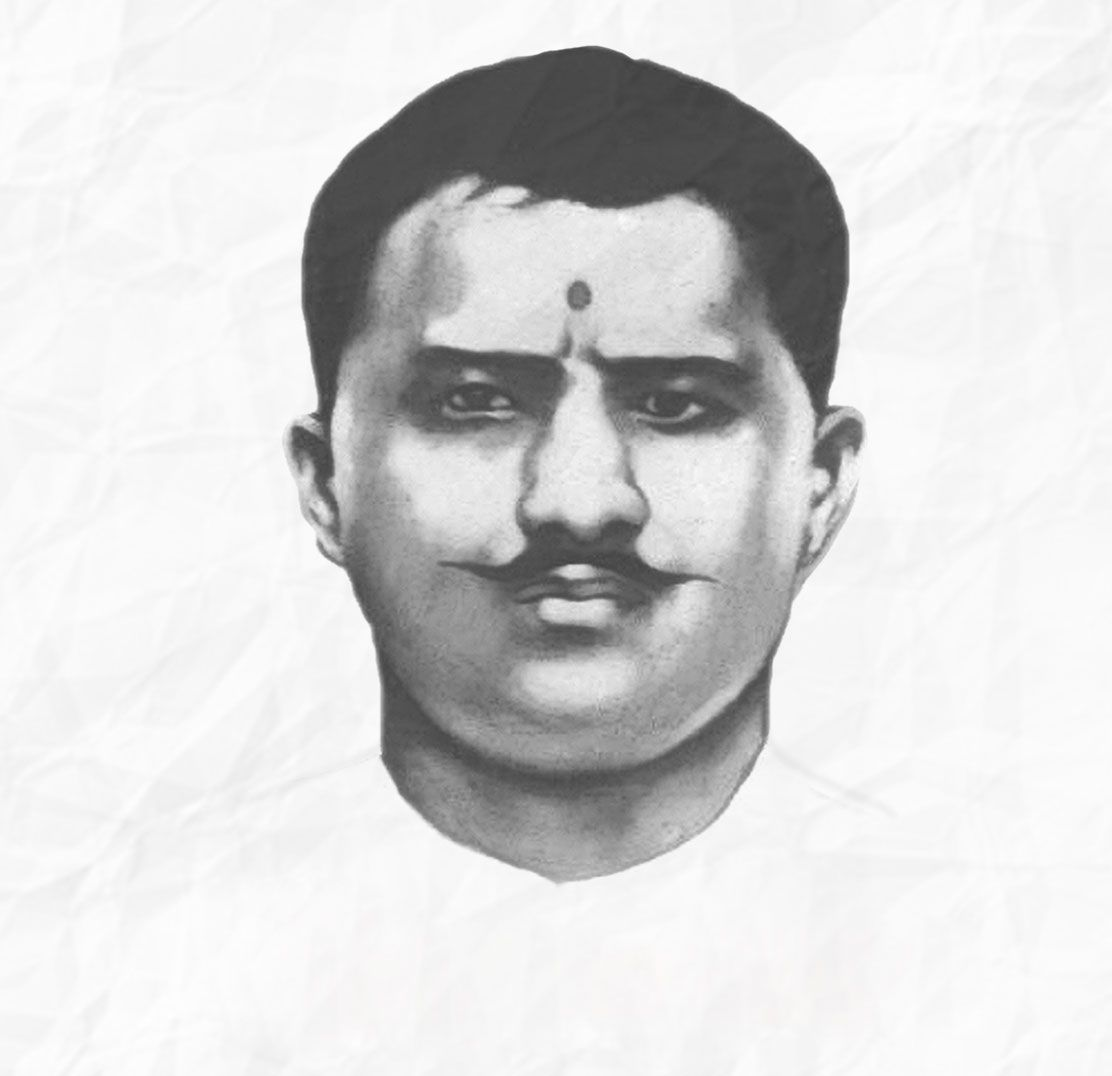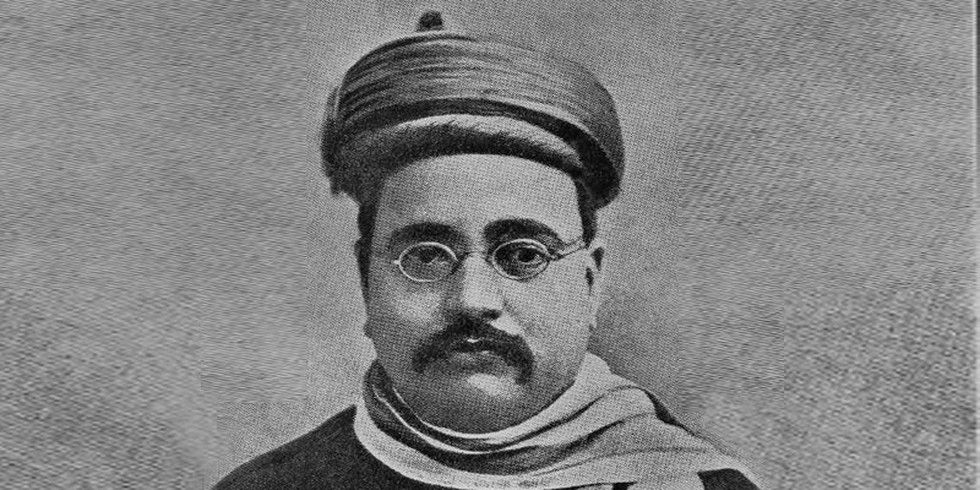Uttar Pradesh Switch to Hindi
Birth Anniversary of Ram Prasad Bismil
Why in News?
On 11th June 2025, the birth anniversary of freedom fighter Ram Prasad Bismil was commemorated. Renowned for his revolutionary spirit and poetic brilliance, he played a pivotal role in India's struggle against British colonial rule.
Key Points
- Birth and Early Life:
- Ram Prasad Bismil was born on 11th June 1897 in Shahjahanpur district of Uttar Pradesh.
- Early Influences and Ideology:
- Bismil joined the Arya Samaj, founded by Dayanand Saraswati in 1875, and began writing under pen names like ‘Bismil’, meaning ‘wounded’ or ‘restless’.
- He embraced revolutionary ideals after reading about the death sentence awarded to Bhai Parmanand, an Arya Samaj missionary and nationalist.
- At the age of 18, he expressed his anguish through the powerful poem ‘Mera Janm’.
- He supported armed revolution, believing it to be a more effective path to independence than Gandhi’s non-violent approach.
- Major Contributions:
- Mainpuri Conspiracy:
- Disillusioned with the Congress’s moderate stance, Bismil founded a revolutionary group named Matrivedi.
- He was involved in the Mainpuri Conspiracy of 1918, wherein the police found a few young people, including Bismil selling books that were prescribed by the government.
- He and his associates carried out three successful raids to loot government funds to support their cause.
- Formation of Hindustan Republican Association (HRA):
- In 1924, Bismil co-founded the Hindustan Republican Association (HRA) with Sachindra Nath Sanyal, Ashfaqulla Khan, Jogesh Chandra Chatterjee and Jadugopal Mukherjee.
- He drafted most of HRA's manifesto, envisioning a federal "United States of India" established through armed revolution.
- Kakori Train Action:
- In 1925, Bismil, along with Chandrasekhar Azad and Ashfaqulla Khan, led the Kakori train robbery to fund revolutionary activities.
- They successfully looted the train near Kakori, but British authorities arrested them within a month.
- After an 18-month-long trial, Bismil, Ashfaqulla Khan, Rajendra Lahiri, and Roshan Singh were sentenced to death under the Kakori Conspiracy Case.
- Mainpuri Conspiracy:
- Literary Contributions:
- Bismil wrote stirring patriotic poetry in Hindi and Urdu that inspired countless Indians to join the freedom struggle.
- Bismil’s poem ‘Sarfroshi Ki Tammana, Ab hamare Dil Me hai’ became a clarion call for the Indian Freedom movement.
- His works reflected deep concerns for social justice, human dignity, and equality.
- Bismil wrote stirring patriotic poetry in Hindi and Urdu that inspired countless Indians to join the freedom struggle.
- Martyrdom:
- The British executed Bismil on 19th December 1927 at Gorakhpur Jail.
Note: In August 2025, the Uttar Pradesh government renamed 'Kakori Kand' to 'Kakori Train Action', stating that the word ‘Kand’ (meaning ‘incident’ or ‘scandal’) carries a negative connotation and undermines the significance of this historic act in India’s freedom struggle.
Uttar Pradesh Switch to Hindi
Ek Ped Maa Ke Naam 2.0 Campaign
Why in News?
As part of the ‘Ek Ped Maa Ke Naam 2.0’ campaign, the National Highways Authority of India (NHAI) launched a tree plantation drive to plant 40,000 trees along the Delhi–Dehradun Corridor in Baghpat, Uttar Pradesh.
Key Points
- Nationwide Impact of ‘Ek Ped Maa Ke Naam 2.0’:
- As part of the ‘Ek Ped Maa Ke Naam 2.0’ initiative, NHAI has already planted over 5.12 lakh trees along National Highways across India.
- The second phase was launched by the Prime Minister on World Environment Day, 5th June, 2025.
- It aims to honor mothers by encouraging tree planting in their names, combining environmental conservation with a tribute to motherhood, symbolizing how mothers, like trees, nurture and sustain life.
- The campaign envisions:
- Complete saturation of tree plantations along highways
- Involvement of multiple stakeholders including government bodies, local authorities, and communities
- Creation of a green, resilient, and sustainable National Highway network
- National Highways Authority of India (NHAI):
- About: NHAI was set up under the NHAI Act, 1988 under the administrative control of the Ministry of Road Transport and Highways (MoRTH).
- Objective: It has been entrusted with the National Highways Development Project (NHDP), along with other minor projects for development, maintenance and management.
- NHDP, started in 1998, is a project to upgrade, rehabilitate and widen major highways in India to a higher standard.
- Vision: To meet the nation’s need for the provision and maintenance of the National Highways network to global standards and to meet the user’s expectations in the most time-bound and cost-effective manner and promote economic well-being and quality of life of the people.
Rajasthan Switch to Hindi
Indian Army Successfully Trials Rudrastra UAV in Pokharan
Why in News?
The Indian Army successfully conducted trials of the Rudrastra hybrid Vertical Take-Off and Landing (VTOL) UAV in Pokharan, Rajasthan.
- Developed by Solar Defence and Aerospace Limited, the UAV is part of India’s ongoing efforts to enhance its indigenous defense capabilities.
Key Points
- Key Features and Capabilities of Rudrastra UAV:
- The indigenous VTOL UAV is named Rudrastra, symbolising the strength of Atmanirbharta (self-reliance in defence).
- Key features demonstrated during trials included:
- Vertical take-off and landing (VTOL)
- Long-endurance missions
- Real-time video transmission
- Precision engagement
- Operational flexibility in rugged terrain
- Trial Performance:
- Rudrastra maintained a stable real-time video link throughout its mission.
- It successfully operated within a mission radius of over 50 km and returned to the launch point without any issue.
- Including target loitering, the UAV covered a range of over 170 km with an endurance of approximately 1.5 hours.
- Applications and Strategic Utility:
- The Rudrastra can be used for surveillance, reconnaissance, and target engagement, making it ideal for mountainous or hard-to-access areas.
- VTOL UAVs require no runway, offering flexibility for quick deployment in diverse operational environments.
- India’s Push for Advanced UAVs After Operation Sindoor:
- Operation Sindoor marked India’s first large-scale non-contact military operation using drones, missiles, and precision munitions.
- This experience highlighted the critical need for advanced UAV capabilities in modern combat scenarios.
- In response the Indian Army has intensified efforts to induct more UAVs to strengthen India’s preparedness against similar non-contact threats in the future.
Jammu & Kashmir Switch to Hindi
Surinsar-Mansar Wildlife Sanctuary
Why in News?
The Jammu and Kashmir Government has formed a Divisional Level Committee to monitor the Eco-Sensitive Zone surrounding the Surinsar-Mansar Wildlife Sanctuary.
- The committee will monitor compliance with the provisions issued by the Ministry of Environment, Forest and Climate Change (MoEFCC).
Key Points
- Surinsar-Mansar Wildlife Sanctuary:
- About:
- This Sanctuary has twin lakes namely Surinsar and Mansar.
- It spreads across three districts in Jammu & Kashmir: Jammu, Udhampur, and Samba.
- Wildlife Richness:
- Prominent mammal species include Nilgai (Blue Bull), Indian Barking Deer, Leopard, Wild Boar, Jackal, Fox.
- The sanctuary’s forests host a wide variety of trees, shrubs, and climbers.
- Due to the presence of high diversity of migratory birds Mansar and Surinsar wetlands were designated as Ramsar site in 2005 and claimed as ‘Internationally important Wetland area’.
- These two sites support population of CITES and IUCN Red listed turtle species as well as one endemic and endangered medusa species i.e. Mansariella lacustris.
- Beside the above uniqueness these two lakes were considered to be important habitats for near about 50 species of fish fauna.
- About:
Eco-Sensitive Zones (ESZs)
- The National Wildlife Action Plan (2002-2016) of the Ministry of Environment, Forest and Climate Change (MoEFCC) stipulated that state governments should declare land falling within 10 km of the boundaries of national parks and wildlife sanctuaries as eco-fragile zones or Eco-Sensitive Zones (ESZs) under the Environmental (Protection) Act, 1986.
- While the 10-km rule is implemented as a general principle, the extent of its application can vary. Areas beyond 10 km can also be notified by the Union government as ESZs, if they hold larger ecologically important “sensitive corridors”.
- The basic aim is to regulate certain activities around National Parks and Wildlife Sanctuaries so as to minimise the negative impacts of such activities on the fragile ecosystem encompassing the protected areas.
Maharashtra Switch to Hindi
Servants of India Society (SIS)
Why in News?
Tensions have reignited between Pune-based Gokhale Institute of Politics and Economics (GIPE) and its parent body, the Servants of India Society (SIS), with both parties express concerns regarding financial management matters.
Key Points
- Servants of India Society (SIS):
- About
- Established on 12th June 1905, in Pune by Gopal Krishna Gokhale, along with G.K. Devadhar, A.V. Patwardhan, and N.A. Dravid.
- Gokhale envisioned the Society as a platform to train committed individuals who would serve the nation with a spirit of dedication and service.
- The Society aimed to promote political education, constructive agitation, and constitutional methods to further India's national interest.
- Members were viewed as missionaries of Indian nationalism, working for the upliftment of the people.
- Prominent Members and Contributions:
- Early members included influential nationalists like V.S. Srinivasa Sastri, Hriday Nath Kunzru, and A.V. Thakkar.
- The Society made notable contributions to India's independence movement, and its ideals continue to shape Indian public life.
- The Society played a key role in shaping India’s freedom struggle by nurturing leaders committed to non-violence, reform, and constitutionalism.
- About
Gopal Krishna Gokhale
- Early Life and Education:
- Gopal Krishna Gokhale was born on 9th May 1866 in Maharashtra.
- He belonged to the first generation of Indians to receive a university education and graduated from Elphinstone College in 1884.
- Gokhale was deeply influenced by Western political thought, especially the ideas of John Stuart Mill and Edmund Burke.
- He considered Justice Mahadev Govind Ranade his mentor and was regarded as Ranade’s “Manas Putra” (spiritual son).
- Political Career and Reform Work:
- He became a senior leader of the Indian National Congress and played a vital role in its moderate faction.
- In 1905, he founded the Servants of India Society to promote education, social reform, and constitutional methods for achieving self-rule.
- Through his roles in the Congress, legislative councils, and civil society, Gokhale persistently advocated for social and political reforms.
- Mentorship to Mahatma Gandhi:
- Gokhale was a mentor to Mahatma Gandhi, especially after Gandhi’s return from South Africa.
- He introduced Gandhi to the realities of Indian society and politics and helped shape his early views on reform and nation-building.
- Legislative Contributions:
- His testimony before the Welby Commission on India's finances earned him national acclaim.
- Gokhale’s budget speeches in the Central Legislative Council stood out for their depth and statistical rigor.
- He played a key role in the formulation of the Morley-Minto Reforms (1909), which expanded Indian participation in governance.
- Legacy and Death:
- Gokhale was known as a scholar-statesman and is often hailed as India’s greatest liberal leader of his time.
- He passed away on 19th February 1915.


.png)





 PCS Parikshan
PCS Parikshan




